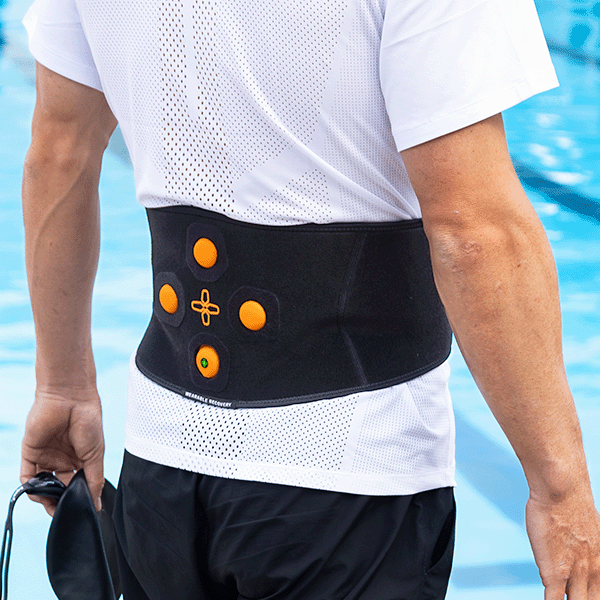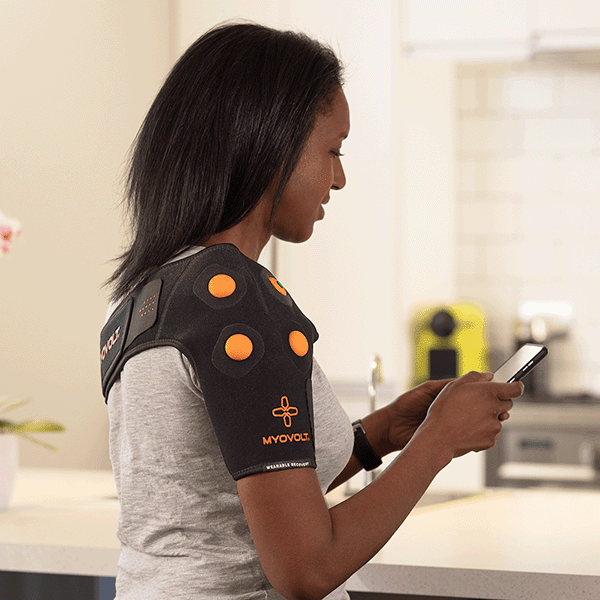Optimizing thermal benefits for muscle performance and recovery.
Thermal effects of Myovolt technology.
Optimizing thermal benefits for muscle performance and recovery.
Thermal effects of Myovolt technology.
Focal muscle vibration is clinically proven to provide a wide range physiological benefits for musculoskeletal performance and rehabilitation. Myovolt delivers Focal Vibration in a wearable format specifically engineered to provide optimal temperature conditions to amplify these benefits.
How does Myovolt deliver and control thermal lift?
- Gentle warming provided by the vibration actuators radiates outward from the treatment zone and is transmitted to the body.
- Increased blood flow is stimulated by Focal Vibration treatment which elevates tissue temperature in the application area.
- Insulation and Far Infrared reflection by the Myovolt compression garment effectively retains and amplifies the increase in temperature from the above two processes.
Myovolt technology has been developed to provide an optimum thermal output whilst minimizing bulk and weight of the device for comfort on the body. Myovolt does not use high current, resistive heating elements so is more energy efficient and does not need to be powered by a heavy battery pack.
Fig 1: Myovolt technology showing thermal output of the device in operation
Myovolt technology has been developed to provide an optimum thermal output whilst minimising bulk and weight of the device for body worn comfort. Myovolt does not use high current, resistive heating elements so is more energy efficient and does not need to be powered by a heavy battery pack.
Fig 1: Myovolt technology showing thermal output of the device in operation
Fig 2: Tissue temperature after Myovolt treatment and device removed.
Fig 2: Tissue temperature after Myovolt treatment and device removed.
Temperature analysis has shown the effectiveness of the device in lifting skin surface temperature and dissipating warmth throughout the application area. As the warming effect develops it is further amplified by the Focal Vibration treatment and together with the insulative effect of the garment the localised temperature is optimised over course of a 10 minute treatment.
What is the optimum temperature zone to maximise benefits?
Bringing the warmth - for performance.
The optimum muscle tissue temperature for peak power performance in sports can vary depending on the specific sport or activity, but generally falls within a range of 38-40°C (100.4-104°F). Research has shown that muscle temperature has a significant impact on muscle performance**. When muscle temperature increases, there is an increase in blood flow to the muscles, which can improve muscle function and contractility. Additionally, higher muscle temperatures allow for greater flexibility and range of motion, which can improve overall athletic performance.
It is important to note that excessively high muscle temperatures can also have negative effects on performance so keeping the temperature in the ‘goldilocks’ zone to avoid overheating is important. Athletes and coaches should strive to achieve and maintain the optimum muscle temperature range through proper warm-up and cool-down techniques and this can be achieved with the use of Myovolt during these times.
Thermal optimization for rehabilition.
Optimizing temperature is not only important for maximising sports performance but plays a part in rehabilitation treatment of musculoskeletal (MSK) issues so lets talk rehab. For sub-acute or chronic injuries, the optimum muscle tissue temperature for rehabilitation typically ranges from 40-45°C (104-113°F) for 15-20 minutes at a time. This temperature range helps by increasing blood flow to the injured area, reduce muscle spasms, promoting tissue healing and is commonly used for heat therapy (known as thermotherapy).
What is the optimum temperature zone to maximise benefits?
Bringing the warmth - for performance.
The optimum muscle tissue temperature for peak power performance in sports can vary depending on the specific sport or activity, but generally falls within a range of 38-40°C (100.4-104°F). Research has shown that muscle temperature has a significant impact on muscle performance**. When muscle temperature increases, there is an increase in blood flow to the muscles, which can improve muscle function and contractility. Additionally, higher muscle temperatures allow for greater flexibility and range of motion, which can improve overall athletic performance.
It is important to note that excessively high muscle temperatures can also have negative effects on performance so keeping the temperature in the ‘goldilocks’ zone to avoid overheating is important. Athletes and coaches should strive to achieve and maintain the optimum muscle temperature range through proper warm-up and cool-down techniques and this can be achieved with the use of Myovolt during these times.
Thermal optimistaion for rehabilition.
Optimising temperature is not only important for maximising sports performance but plays a part in rehabilitation treatment of musculoskeletal (MSK) issues so lets talk rehab. For sub-acute or chronic injuries, the optimum muscle tissue temperature for rehabilitation typically ranges from 40-45°C (104-113°F) for 15-20 minutes at a time. This temperature range helps by increasing blood flow to the injured area, reduce muscle spasms, promoting tissue healing and is commonly used for heat therapy (known as thermotherapy).
The main effects of thermal optimization:
- Increased blood flow
Heat causes blood vessels in the injured area to dilate (widen), increasing blood flow to the area. This increased blood flow can help to deliver important nutrients and oxygen to the injured tissues, aiding in the healing process. - Reduced muscle spasms
Heat can help to relax muscles, reducing muscle spasms and tightness that can contribute to pain and inflammation. - Decrease in pain
Heat can help to decrease pain by numbing the nerve endings in the injured area, reducing the transmission of pain signals to the brain. - Promoting tissue healing
Heat can promote tissue healing by increasing metabolic rate and cellular activity, which can accelerate the healing process in the injured tissues. - Improving range of motion
Heat can help to increase flexibility and range of motion in the injured area, making it easier to perform exercises and rehabilitation activities that may be necessary for recovery.
Overall, Myovolt can optimize and control the thermal conditions of the treatment area in a safe and effective way to manage pain and promote healing in sub-acute conditions.
The main effects of thermal optimization:
- Increased blood flow
Heat causes blood vessels in the injured area to dilate (widen), increasing blood flow to the area. This increased blood flow can help to deliver important nutrients and oxygen to the injured tissues, aiding in the healing process. - Reduced muscle spasms
Heat can help to relax muscles, reducing muscle spasms and tightness that can contribute to pain and inflammation. - Decrease in pain
Heat can help to decrease pain by numbing the nerve endings in the injured area, reducing the transmission of pain signals to the brain. - Promoting tissue healing
Heat can promote tissue healing by increasing metabolic rate and cellular activity, which can accelerate the healing process in the injured tissues. - Improving range of motion
Heat can help to increase flexibility and range of motion in the injured area, making it easier to perform exercises and rehabilitation activities that may be necessary for recovery.
Overall, Myovolt can optimize and control the thermal conditions of the treatment area in a safe and effective way to manage pain and promote healing in sub-acute conditions.
These references provide more in-depth information about the relationship between muscle temperature and athletic performance, as well as strategies for achieving and maintaining an appropriate muscle temperature for optimal performance.
1.
Bishop, D. (2003). Warm up I: potential mechanisms and the effects of passive warm up on exercise performance. Sports Medicine, 33(6), 439-454. doi: 10.2165/00007256-200333060-00005
2.
Sargeant, A.J. Effect of muscle temperature on leg extension force and short-term power output in humans. Europ. J. Appl. Physiol. 56, 693–698 (1987). https://doi.org/10.1007/BF00424812
3.
Saunders, P. U., Pyne, D. B., Telford, R. D., & Hawley, J. A. (2004). Factors affecting running economy in trained distance runners. Sports Medicine, 34(7), 465-485. doi: 10.2165/00007256-200434070-00005
4.
Reducing Muscle Temperature Drop after Warm-up Improves Sprint Cycling Performance https://journals.lww.com/acsm-msse/Fulltext/2013/02000/Reducing_Muscle_Temperature_Drop_after_Warm_up.20.aspx
Here are some references specifically supporting the use of thermotherapy for the rehabilitation of sub-acute and chronic injuries:
5.
Brosseau L, Yonge KA, Robinson V, et al. Thermotherapy for treatment of osteoarthritis. Cochrane Database Syst Rev. 2003;(4):CD004522. doi:10.1002/14651858.CD004522
6.
Kim K, Monroe JC, Gavin TP, Roseguini BT. Local Heat Therapy to Accelerate Recovery After Exercise-Induced Muscle Damage. Exerc Sport Sci Rev. 2020 Oct;48(4):163-169. doi: 10.1249/JES.0000000000000230. PMID: 32658042; PMCID: PMC7492448.
7.
Dehghan M, Farahbod F. The efficacy of thermotherapy and cryotherapy on pain relief in patients with acute low back pain, a clinical trial study. J Clin Diagn Res. 2014 Sep;8(9):LC01-4. doi: 10.7860/JCDR/2014/7404.4818. Epub 2014 Sep 20. PMID: 25386469; PMCID: PMC4225921.
8.
Karagülle MZ, Karagülle M, Karagülle O, et al. Balneotherapy in fibromyalgia: a single blind randomized controlled clinical study. Rheumatol Int. 2007;27(5):441-446. doi:10.1007/s00296-006-0246-0
9.
National Institute for Health and Care Excellence (NICE). Osteoarthritis: care and management. NICE guideline [CG177]. 2014. https://www.nice.org.uk/guidance/cg177/chapter/1-Recommendations#thermotherapy.



